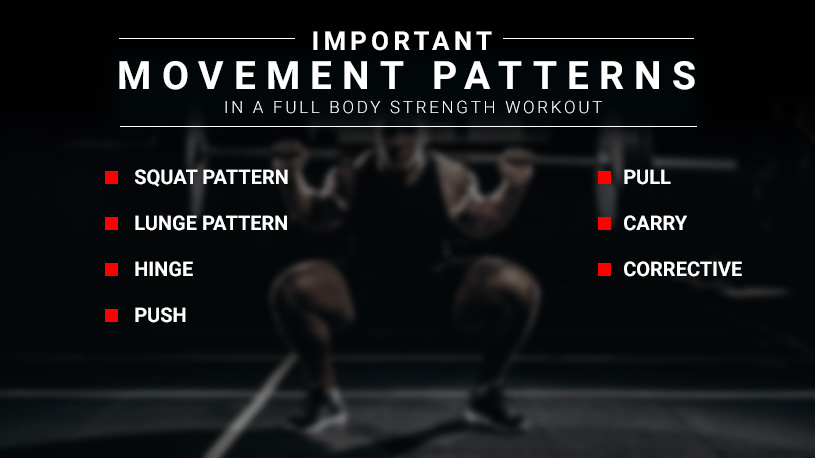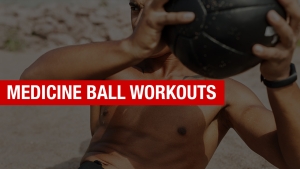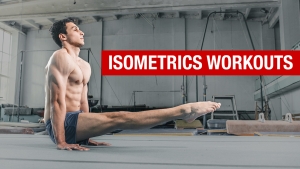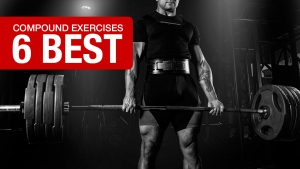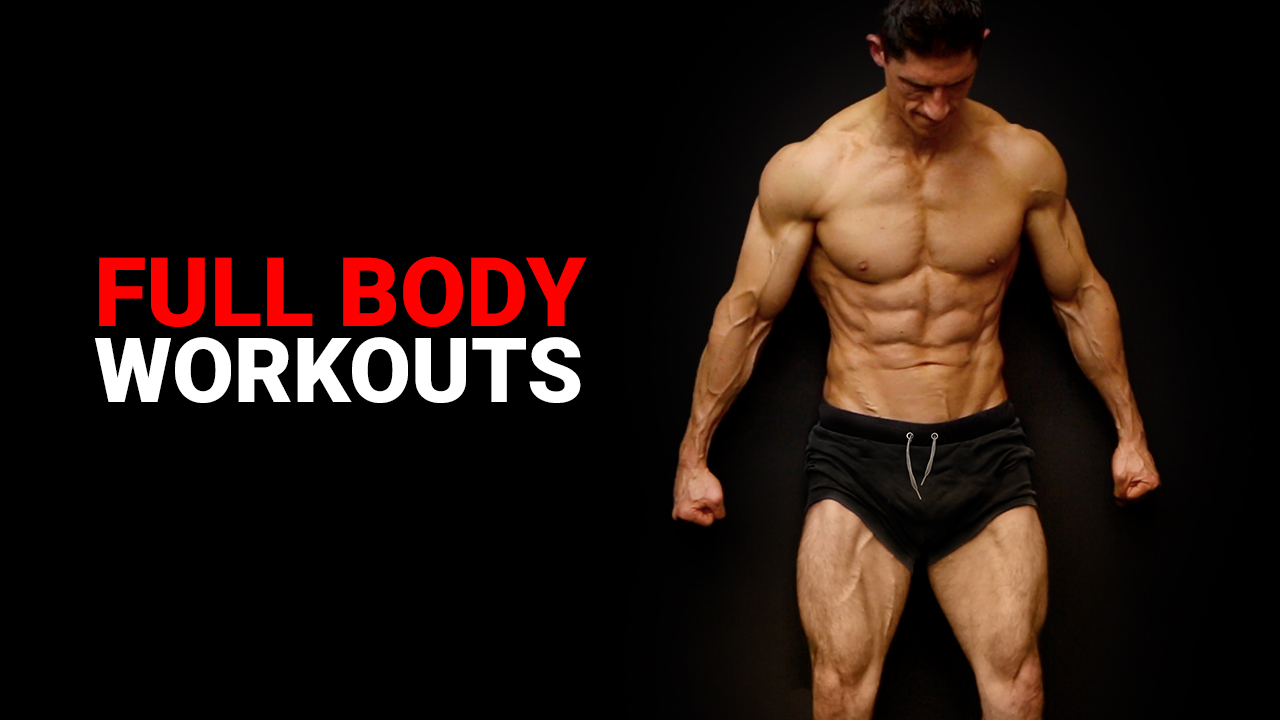
THE ULTIMATE FULL BODY WORKOUT GUIDE
Full body workouts are one of the most efficient and effective types of training, whether you’re performing them with barbells, dumbbells, or even full body workouts at home with no equipment at all.
Some people are surprised to find that it’s possible to maintain and even improve their physiques, and they don’t need a bro split program or a classic PPL routine. For folks with a busy schedule, a full body workout programs are time efficient and can cut your training days down to as low as 3 days per week. Full body training programs are ideal for the beginner lifter or for anyone involved in other athletic activities.
Not all full body workouts are created the same. If you’ve never performed or tried to create one, you might not know what to look for in a full body workout.
That’s where this complete guide on the best full body workout can help.
I’m going to cover the benefits of full body workouts and there are some you might not know about. But I’ll also discuss the important movement patterns in a full body workout, the best full body workout for beginners, and the most commonly asked questions relating to full body workouts.
I’ve broken this step-by-step guide into sections to help you quickly find what you’re looking for as it relates to where you are in your fitness journey. Here are the topics I’ll be covering in this exercise guide:
1) IMPORTANT MOVEMENT PATTERNS IN A FULL BODY WORKOUT
Rather than put all your focus on specific lifts and how they will target muscles, I recommend that you try to think in terms of movement types.
You’ll get the best full body workout session you’ve ever done if you concentrate of exercises that coincide with the following movement patterns:
- Squat pattern
- Lunge pattern
- Hinge (Hip Driven)
- Push
- Pull
- Carry
- Corrective
For example, don’t ask yourself, “What is the best full body workout for targeting my quads and back?” Instead, you should be asking, “Which exercises allow me to utilize a squat pattern for movement?”
The right combination of these seven movement patterns in your full body split will help you hit all the major functions of performance, build muscle efficiently, maintain a healthy weight, and prevent injury.
2) WHAT ARE THE BENEFITS OF FULL BODY WORKOUTS?
Having a full body workout plan is incredibly beneficial for a multitude of fitness goals including muscle gain, strength development, weight reduction, and more.
Let’s explore the benefits of full body workout routines to see why they’re integral for success.
TARGETS MULTIPLE MAJOR MUSCLE GROUPS
The best full body gym workout allows you to train the major muscle groups of the body utilizing compound moves. These exercises involve multiple muscle groups at once, which leads to increased strength and improved overall performance.
FOCUS ON ATHLETICISM AND FUNCTIONALITY
Exercises that require multiple muscle groups working together help you build total-body strength and lean muscle more quickly. But more importantly, you’ll be doing so in an athletic and functional way.
Again, we’re not talking about your typical “one-size-fits-all” full body workout with dumbbells.
The exercises in the full body workout routine I’m going to share with you have been selected to complement the seven movement patterns discussed above. These exercises are going to help you achieve your fitness goals but also become a more well-rounded athlete.
PERFECT FOR MUSCLE GROWTH AND STRENGTH
According to science, muscles grow the most when they’re stimulated every 48 hours. A full body workout with weights takes this into account by hitting all muscle groups several times over the course of several days.
Training your entire body every other day with a three day fast full body workout allows for more frequent stimuli for protein synthesis, more accrued volume, and more training sessions over a given period of time, leading to an overall more muscular physique.
EFFICIENT USE OF TIME
With a full body circuit workout, you’ve got a time-efficient routine. You’re able to maximize your time in the gym as you will be working multiple muscles at once. This allows you to burn more calories and target different muscle groups faster than with other types of training.
IMPROVED CARDIOVASCULAR HEALTH
A full body workout gym or home-based can also improve cardiovascular health by increasing your heart rate while working multiple muscles. This helps build endurance and stamina, which can benefit your overall fitness.
3) WHAT IS THE BEST FULL BODY WORKOUT?
The best full-body workout routine should include exercises that focus on every muscle group and all the major movement patterns.
Naturally, you want to tailor the exercise to your goals and ability level, but overall, the full body workout program should involve compound movements that target multiple muscle groups simultaneously.
And as I mentioned above, picking the best exercises for your full body routine isn’t about targeting specific muscle groups – it’s about pairing exercises with movement patterns.
We’ll start out with a number of barbell exercises and then move on to a dumbbell exercise followed by a cable exercise.
SQUAT PATTERN
The squat movement pattern is the primary driver for leg development. A squat-pattern exercise is a great choice for a full body weight lifting workout as it engages multiple muscle groups at once – the quads, hams, calves, glutes, and hip flexors.
One of the best exercises to include in your full body barbell workout is the Barbell Back Squat.
BARBELL SQUAT


HOW TO DO THE BARBELL SQUAT:
- Start this lift by standing with your feet shoulder-width apart and your hands just wider than shoulder-width apart, taking an overhand grip on the bar that is positioned behind your head.
- From a standing position, lower your body by bending your knees until your thighs are parallel to the floor.
- Return to the starting position by pushing back up through your feet.
WHAT MAKES IT EFFECTIVE: The Barbell Squat is an effective workout because it provides the most overload for the quadriceps and glutes, which are the primary muscle groups targeted in this movement. Regardless of whether you want strength or hypertrophy, the Barbell Squat can help you achieve that goal.
LUNGE PATTERN
On the other side of our bodies, we have the lunge movement pattern. This is a complementary pattern to the squat movement pattern. It also helps to build strength and power in the lower body while offering balance from the anterior-focused movements of the squat pattern.
REVERSE BARBELL LUNGE


HOW TO DO THE REVERSE BARBELL LUNGE:
- Stand with your feet together, holding a barbell across the back of your shoulders.
- Step backward into a lunge position, making sure to keep your chest up and core engaged.
- Engage the lower body, contracting your hamstrings and quads to return to standing position.
- Repeat on opposite side and continue alternating.
WHAT MAKES IT EFFECTIVE: The reverse lunge is a safer, more comfortable alternative to the common forward lunge for your knees, and it also effectively works your hamstrings and glutes, making it an obvious choice for your new full body lifting workout.
HINGE PATTERN
The hinge pattern is one of the most important types of movement patterns to learn, perfect, and incorporate into your full body strength workout.
It’s a powerful hip-dominant pattern that develops strength and power in the posterior chain muscles – glutes, hamstrings, and lower back. Given the role it plays in many compound exercises and Olympic lifts, the hinge pattern will help you see better results in dozens of other exercises, not necessarily related to the posterior chain.
In other words, make sure you add it into your full body workout plans!
BARBELL DEADLIFT

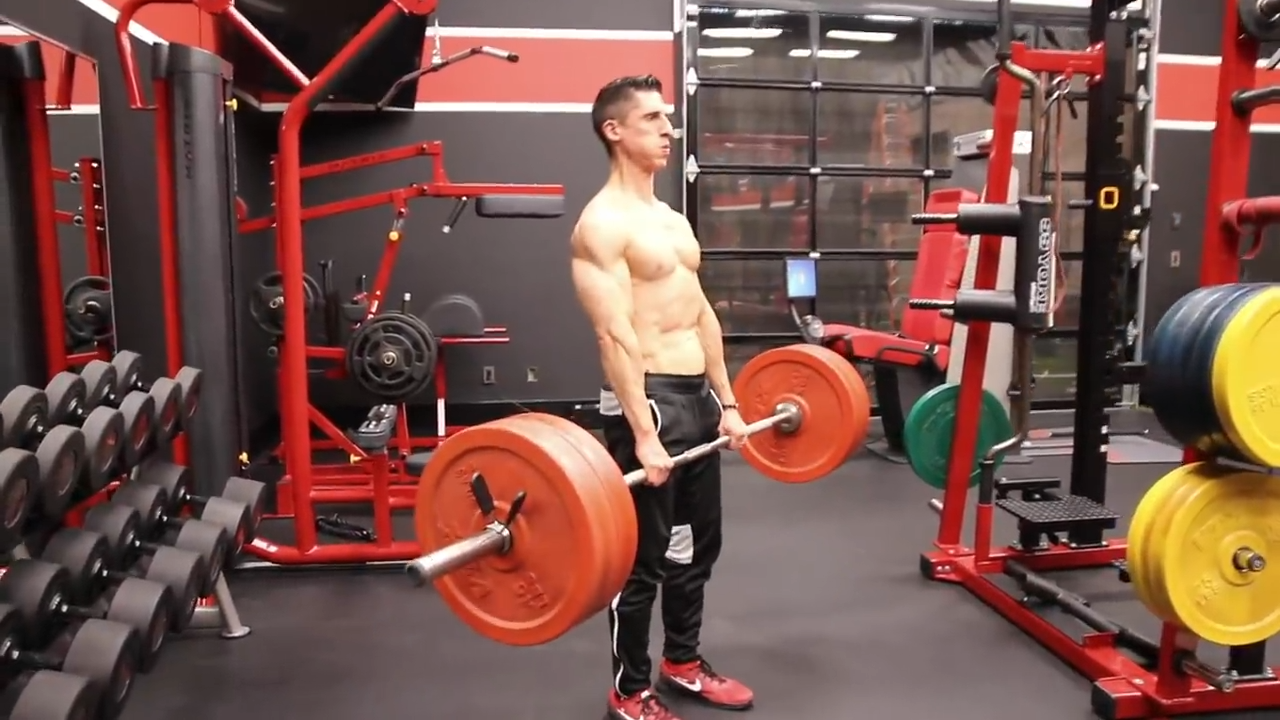
HOW TO DO THE BARBELL DEADLIFT:
- Stand with your feet hip-width apart, toes pointed slightly outward.
- Hold a barbell in front of you with an overhand grip.
- Hinge at the hips and drive your butt back while keeping your chest up and core engaged.
- Lower the barbell to the ground, bending your knees as needed.
- Return to standing position and repeat.
WHAT MAKES IT EFFECTIVE: The Barbell Deadlift is a fantastic way to develop the hip-hinge movement pattern while overloading the posterior chain for strength and muscle gain. As you’ve noticed by this point, a great full body routine is going to focus primarily on compound exercises.
PUSH PATTERN
The push movement pattern is one that many of us are used to doing because we arguably use it the most in our daily lives. While we may have a forward-favoring habit of movement, that doesn’t mean we are necessarily “good” at it.
You can do a lot of “pushing” movements in your day to day, but you must consciously focus on getting stronger in this area to see real change and improvements. That’s why the push movement pattern is key to include in your full body weightlifting workout. It benefits both upper-body strength and size. The primary target muscles in this movement are the upper body muscle groups in the chest, triceps, and shoulders.
BARBELL BENCH PRESS

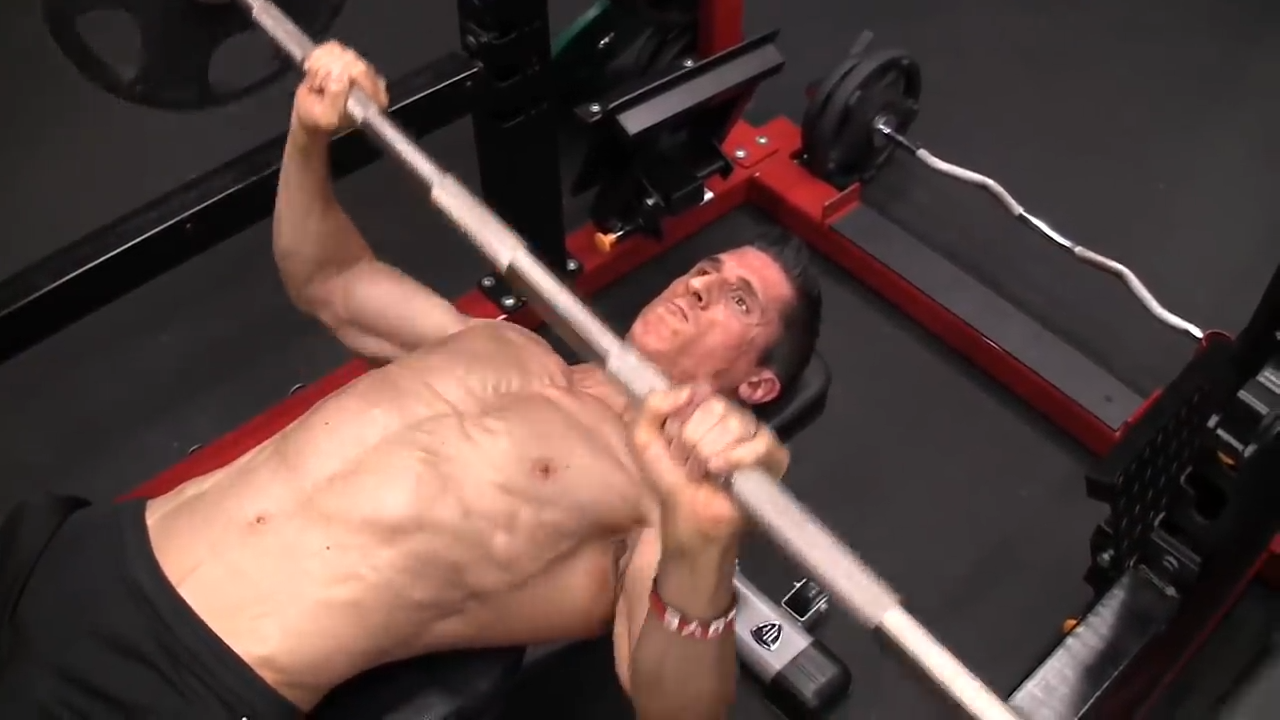
HOW TO DO THE BARBELL BENCH PRESS:
- Lie down on a bench with your feet flat on the floor. Hold a barbell above your chest with an overhand grip.
- Slowly lower the barbell to your chest, pause for a moment and then press it back up to the starting position.
- Make sure to keep your core engaged and chest up throughout the exercise.
WHAT MAKES IT EFFECTIVE: The Barbell Bench Press is one of the most fundamental exercises for the push movement pattern. It targets all the “pushing” muscle groups and allows you to focus on hypertrophy, strength, and power simultaneously, given the right acute variables.
PULL PATTERN
The pulling movement pattern is just as important as the pushing movement pattern for a well-rounded barbell full body workout. It focuses on strengthening your back muscles – lats, traps, rhomboids – and improving shoulder mobility. Just like with any other movement pattern, it benefits from a variety of exercises to target different areas and ranges of motion. Barbell rows are one of the best movements for the pull pattern.
BARBELL ROW


HOW TO DO THE BARBELL ROW:
- Stand with your feet hip-width apart, holding a barbell in front of you.
- Bend your knees slightly and hinge at your hips to lower the barbell toward the ground.
- Keep your core engaged and chest up throughout the exercise.
- When you feel a stretch in your lats, pull the barbell back towards you and squeeze shoulder blades together.
- Pause and then return to the starting position.
WHAT MAKES IT EFFECTIVE: Hands down one of the best back builders, the Barbell Row is just a powerhouse of an exercise that primarily targets the lats as well as several other posterior-chain muscle groups. It also benefits from a variety of variations and progressions that allow you to make small changes to target different areas and strengths.
CARRY PATTERN
The carry movement pattern is a great way to add functional strength and stability to your full body workout routine. It has multiple benefits such as increasing grip strength, core stability, and overall conditioning.
DUMBBELL FARMER’S CARRY

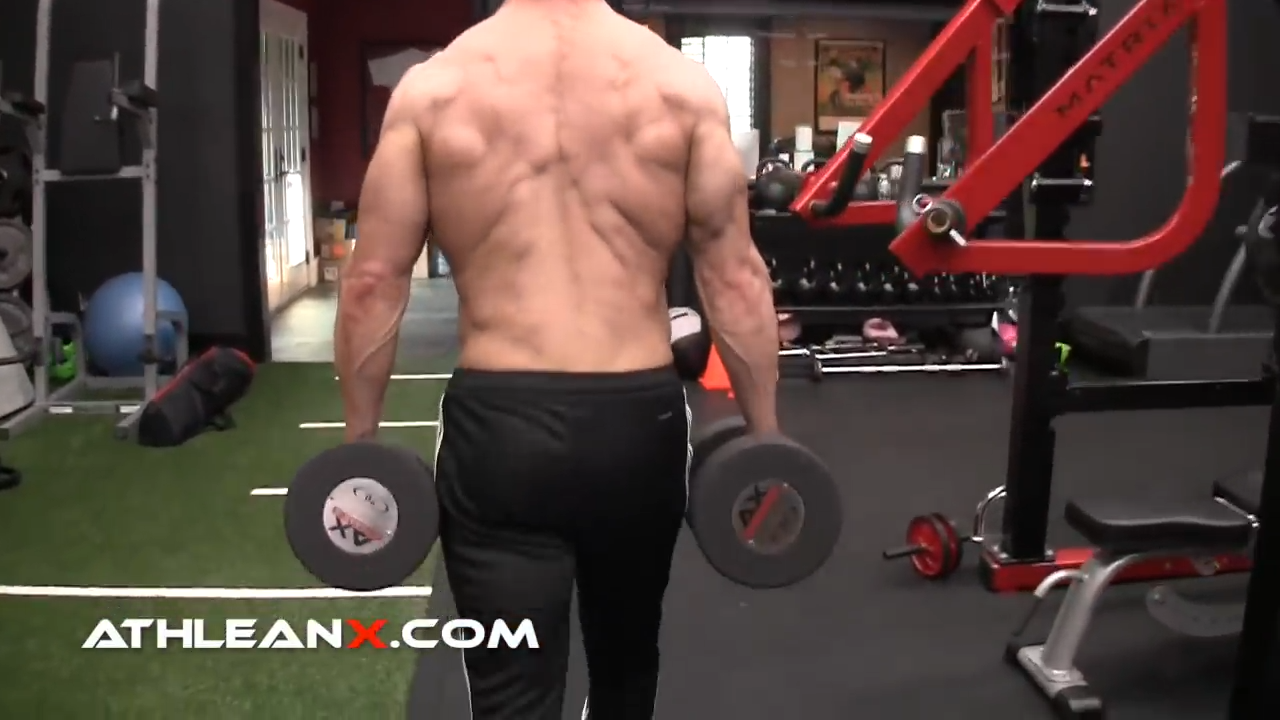
HOW TO DO THE DUMBBELL FARMER’S CARRY:
- Stand with your feet hip-width apart, holding a pair of dumbbells by your sides.
- Engage your core and keep your chest up throughout the exercise.
- Walk forward for the desired number of steps and then return to starting position.
- Make sure to focus on keeping good posture and form throughout the movement.
WHAT MAKES IT EFFECTIVE: The Farmer’s Carry is a great exercise to include in the best full body dumbbell workout because it has many benefits. Some of these benefits include getting an additional conditioning effect from the carry, building grip sustainability, and improving our major lifts.
CORRECTIVE PATTERN
Finally, we have the corrective movement pattern, which focuses on offsetting and balancing the work done in the other movement patterns. The best full body workout will always have corrective movement patterns as the core of the program since it helps to improve posture, increase flexibility, and activate muscles that are often neglected.
FACE PULL


HOW TO DO THE FACE PULL:
- Attach a rope handle to the top pulley of a cable machine.
- Take hold of the handles with an overhand grip and step away from the machine, making sure there is tension on the cable.
- Pull your hands apart until they are at ear level, pause for a moment, and then slowly return to starting position.
- Make sure to keep your chest up and core engaged throughout the exercise.
WHAT MAKES IT EFFECTIVE: The Face Pull is an excellent upper-body exercise, and lifters should do it a few times per week. The routine helps offset any potential muscle imbalances resulting from all the pushing we do while also stabilizing muscles in the shoulder and rotator cuff areas.
If you’re looking for a complete full body workout plan that you can do at the gym, check out my article the Full Body Workout Plan.
4) WHAT IS THE BEST FULL BODY WORKOUT WITH DUMBBELLS?
Barbells and cable machines aren’t the only way to get in a great workout. You can also try a dumbbell full body workout.
When it comes to full body workouts with dumbbells, there are a variety of exercises you can include.
If you only have access to a set of dumbbells, here are the exercises I’d recommend incorporating into your program.
DUMBBELL CLEAN UP AND OVER

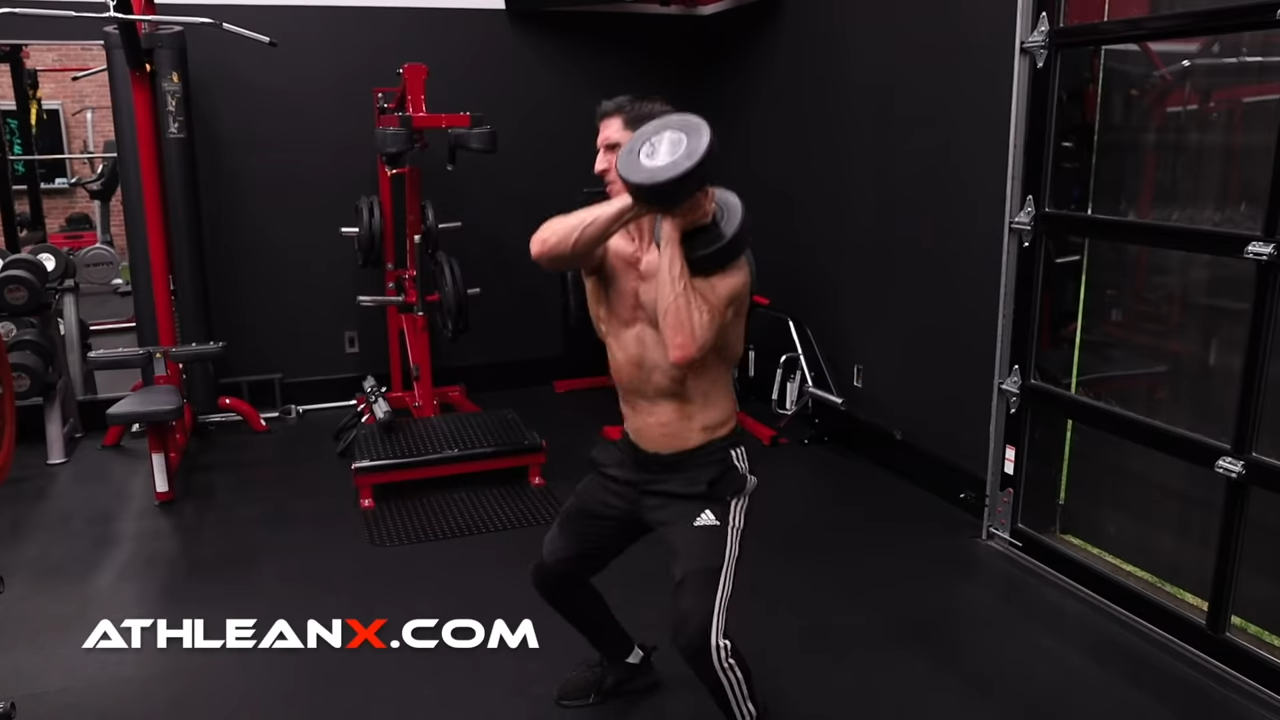
HOW TO DO THE DUMBBELL CLEAN UP AND OVER:
- Clean the dumbbell explosively up to one shoulder, press it overhead to the other side, then bring it back down and repeat.
- Catch the dumbbell on your shoulder at the same time you plant your feet flat so that you’re in contact with the ground, ready to absorb the dumbbell weight eccentrically, which prepares you for an explosive overhead clean to the opposite shoulder.
- Proper form is important here. Keep your core tight.
WHAT MAKES IT EFFECTIVE: This exercise will work your shoulders, back, biceps, brachialis and legs all at once, making it a great choice for a full body workout with dumbbells.
DUMBBELL LUNGE

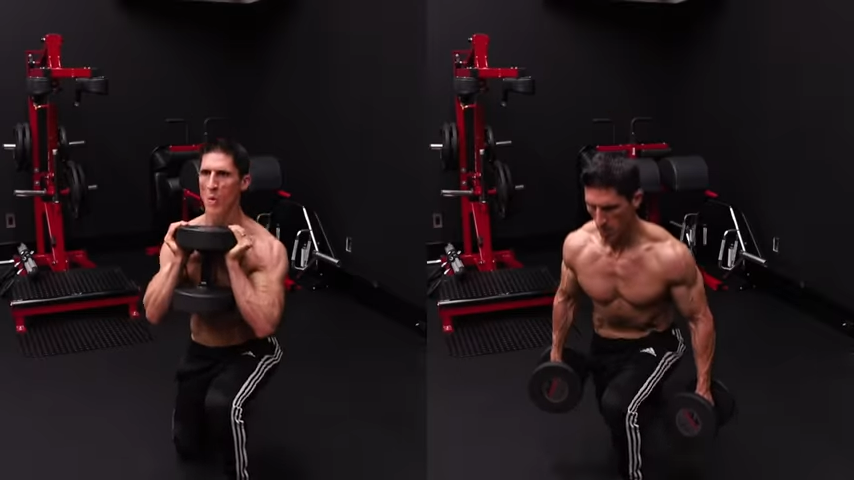
HOW TO DO THE DUMBBELL LUNGE:
- For each leg, do three sets with a weight you can lift six to eight times.
- To complete this exercise correctly, you must keep your feet slightly wider apart.
- People often lunge directly backwards, which can narrow the base of support and result in a loss of balance. Focus on stability by keeping your legs wider apart.
WHAT MAKES IT EFFECTIVE: The dumbbell lunge is an effective exercise for the lower body, specifically targeting the quads and glutes. This movement also helps to increase balance, coordination, and stability. It’s a great way to increase strength in the lower body while improving mobility. You can easily incorporate this one into a full body circuit workout. If you want to focus more on the hamstrings, consider adding in the Hamstring Curl, which can be done with dumbbells or a machine in a traditional seated position.
DUMBBELL T-BAR ROW


HOW TO DO THE DUMBBELL T-BAR ROW:
- Pick a weight that you can lift for six-to-eight repetitions.
- Keep the elbows bent as you bring the dumbbells back.
- Make sure to be careful not to hit yourself with the dumbbells by using a lighter weight until you get used to the movement.
WHAT MAKES IT EFFECTIVE: Leaning forward at the waist while keeping your low back flat ensures a greater load on your lats. This one is a must if you’re performing a dumbbell only full body workout.
FLOOR PRESS

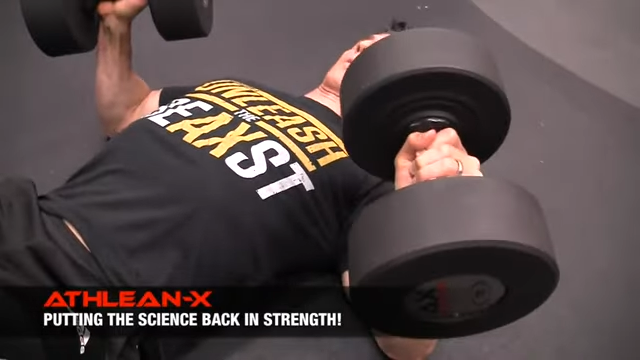
HOW TO DO THE FLOOR PRESS:
- Lie down on the floor with your feet flat and a pair of dumbbells in your hands.
- Curl the weights to chest level, arms bent at 90 degrees.
- Keep your elbows tucked into your sides and press the weights up until your arms are straight.
- Lower them back to chest level, pause for a moment and then repeat.
WHAT MAKES IT EFFECTIVE: The Floor Press targets your chest, shoulders, and triceps – ideal for any upper body workout. If you want to target your shoulders more with dumbbells, then consider adding in a Lateral Raise.
DUMBBELL TRICEPS FLOOR EXTENSIONS

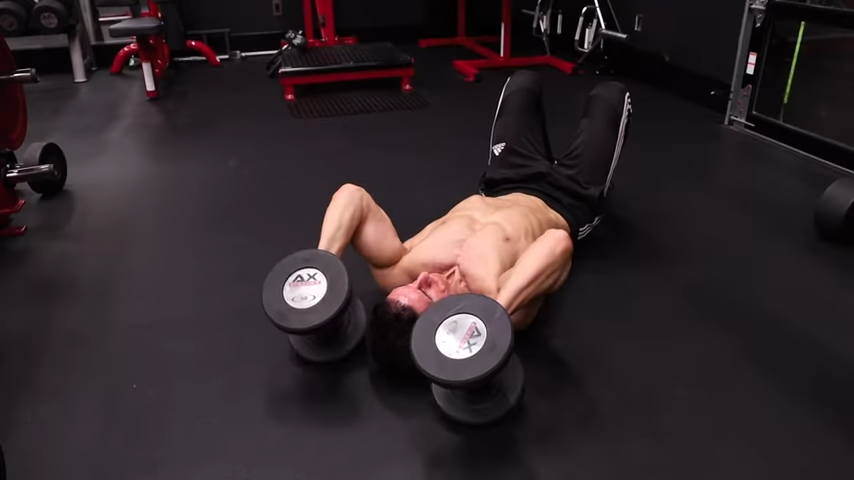
HOW TO DO DUMBBELL TRICEPS FLOOR EXTENSIONS:
- Using a hammer grip on the dumbbells, focus all the motion on your elbow joints and not so much in the lats.
- Shift your attention to your triceps by bending only at the elbow joint and limiting the range of motion to elbow flexion—not shoulder extension.
WHAT MAKES IT EFFECTIVE: Allows you to safely and effectively focus on the elbow flexion needed to fully activate the triceps muscles.
DUMBBELL WAITER CURLS


HOW TO DO DUMBBELL WAITER CURLS:
- The Dumbbell Waiter Curl is a biceps exercise that only requires one dumbbell. Use the palms up grip to hold the weight with both hands at one end. This makes it harder for the biceps by increasing the lever arm’s length by an inch or two.
- Remember to brace your core since the weight will be further in front of you than with classic dumbbell curls.
WHAT MAKES IT EFFECTIVE: If you want to bulk up your biceps, give this curl variation a try. I love it and think you will too. If you only have time to do a 30 minute dumbbell full body workout, make sure you add this one to the list.
For more great examples of full body exercises with dumbbells, check out my article, the Total Body Dumbbell Workout.
5) HOW CAN I DO A FULL BODY WORKOUT AT HOME
The best thing about full body home workouts is that they are both easy to do and extremely effective. All you need is some space at home and the motivation to get it done!
The best way to go about doing a full body workout at home is by incorporating a variety of exercises into your routine that target all major muscle groups. Here’s my favorite full body workout at home without equipment:
RATCHET SQUATS

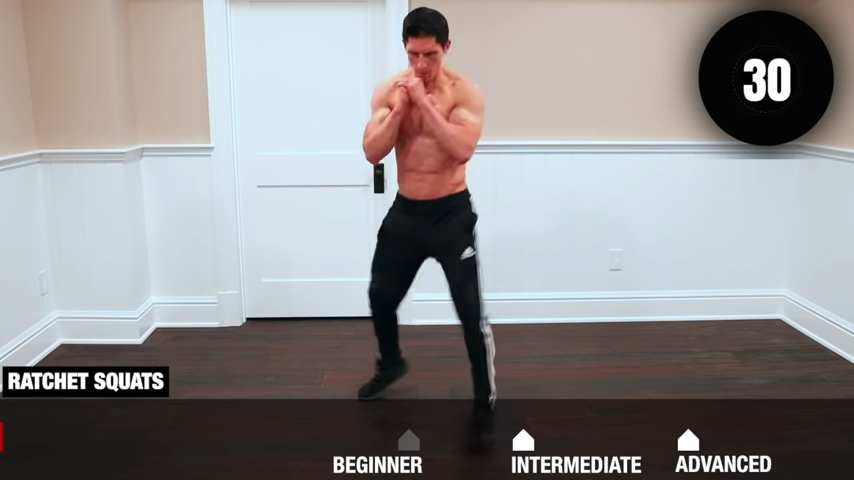
HOW TO DO RATCHET SQUATS:
- The Ratchet Squat gets its name from the quick twist to each side between reps. You’ll start by placing your feet shoulder width apart in a squat position. Put your hands in a prayer grip.
- Next, you will squat down with a hard eccentric squeeze in the quads and glutes while keeping your feet flat.
- When you reach the top of your squat, rotate your hips quickly to one side and back again to the starting position.
- Squat, then twist to the right, squat again, and twist to the left. Repeat this pattern on the other side. Be sure that each time you land, your feet are flat on the floor.
WHAT MAKES IT EFFECTIVE: Even though you aren’t using any external weight, the intensity of the Ratchet Squat ensures that you feel every rep you do.
SHOULDER TAP PIKE PUSHUPS

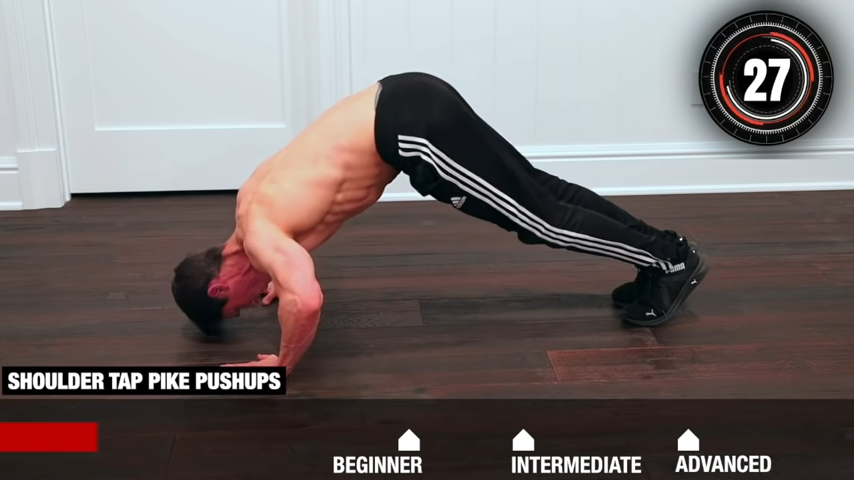
HOW TO DO SHOULDER TAP PIKE PUSHUPS:
- Start this movement in a piked push-up position, with your hips high.
- As you lower yourself toward the floor, keep your core tight. You should aim with your forehead.
- After each pushup, touch your right hand to your left shoulder, then alternate and touch your left hand to your right shoulder.
- Remember to keep your knees locked, shoulders level, and core tight throughout the entire exercise.
WHAT MAKES IT EFFECTIVE: This exercise is an excellent way to work the chest muscles, anterior delts, triceps, and core.
POWER UPS

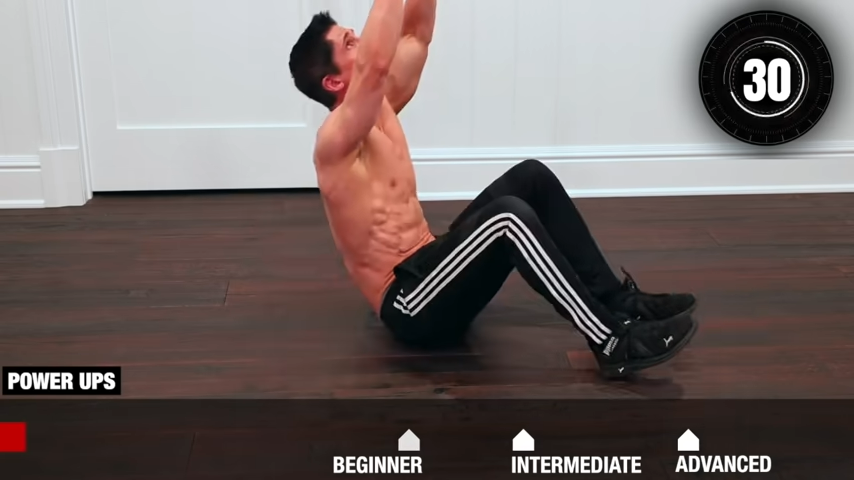
HOW TO DO POWER UPS:
- Lie on your back on the floor, with a slight bend in your knees, and clasp your hands together into a prayer grip.
- Perform a sit-up and drive your hands overhead, bending at the waist to rise to a seated position.
- Slowly lower yourself back to the starting position and squeeze your core as you go.
- Remember to keep a slight bend in your knee throughout the entire movement.
WHAT MAKES IT EFFECTIVE: What makes this so effective for an at home full body workout is the additional extension on the abs. It also helps that you can easily lock your feet into a couch or table for support.
POUNDING TRUNK LIFTS


HOW TO DO POUNDING TRUNK LIFTS:
- Lie on your back on the floor with a slight bend in your knees and move your arms to the sides with upper arms touching the floor.
- Extend your hands toward the ground as if doing a triceps extension, then use the heel of your palms to push yourself off the floor and raise your upper body.
- This exercise is similar to a triceps extension. You will feel the tension in your upper arms.
WHAT MAKES IT EFFECTIVE: Though the Pounding Trunk Lift might resemble a sit-up, it is actually an excellent triceps and posterior shoulder exercise.
BRIDGE REACH OVERS

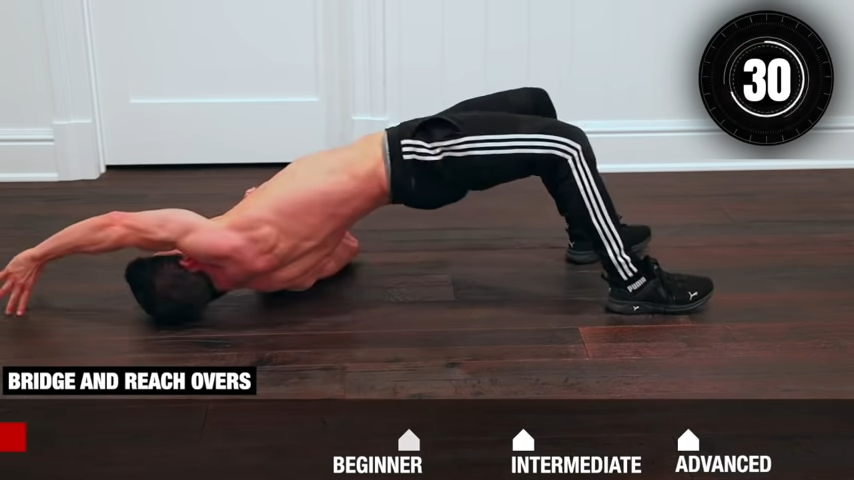
HOW TO DO BRIDGE REACH OVERS:
- Lie on your back with feet shoulder width apart and hips in the air in a bridge position, then twist at the waist to reach for the floor on the opposite side.
- After you relax the Glute Bridge, repeat the movement by twisting to the opposite side.
- You should do this bridge-twist movement to the right and then left continually.
WHAT MAKES IT EFFECTIVE: This exercise shifts the focus to work on the glute muscles. You’ll immediately recognize that the exercise resembles a Glute Bridge, one of the best exercises for the posterior chain to include in your full body at home workout.
TRICEPS TOE TAPS

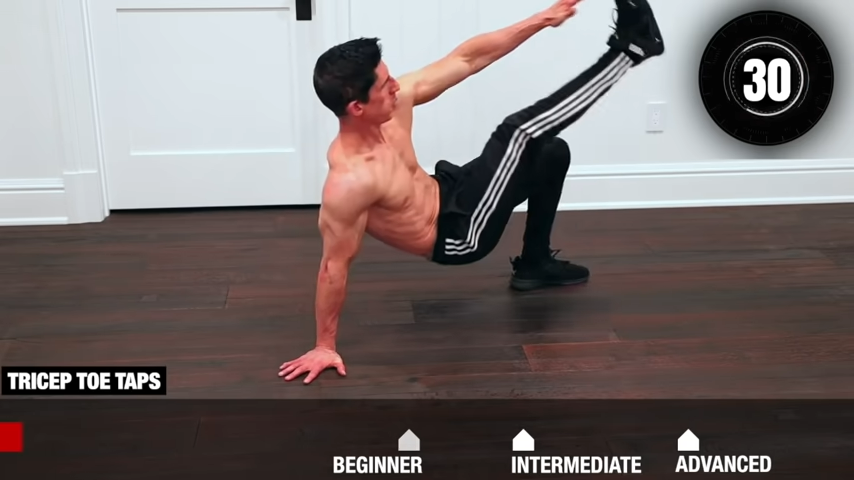
HOW TO DO TRICEPS TOE TAPS:
- For this exercise, start with your feet hip-width apart and arms shoulder-width apart.
- Keeping your hips raised off the floor, take turns touching your toes with each hand.
- First lift your right foot as high as possible and then touch the toe with your left hand.
- Next, repeat with the left foot and right hand.
WHAT MAKES IT EFFECTIVE: As you touch your toe to the opposite side, the Triceps Toe Taps work your internal and external obliques. Additionally, your triceps get a good isometric workout, and of course the hip flexors and glute muscles are utilized.
ANGELS AND DEVILS


HOW TO DO ANGELS AND DEVILS:
- Start by lying on your stomach on the floor, with your feet and shoulders off the ground.
- Bring your arms up over your head in a wide arc, and then bring them back down behind you as far as you can.
- Touch your thumbs together behind your back, then bring your arms overhead again.
- Repeat this motion, keeping your shoulders and feet elevated.
WHAT MAKES IT EFFECTIVE: This one exercise targets several posterior chain muscles while improving muscular endurance and mind-to-muscle connection. I always recommend this one for any full body workout at home for beginners or advanced trainees.
PUSH-UP TOE TAPS

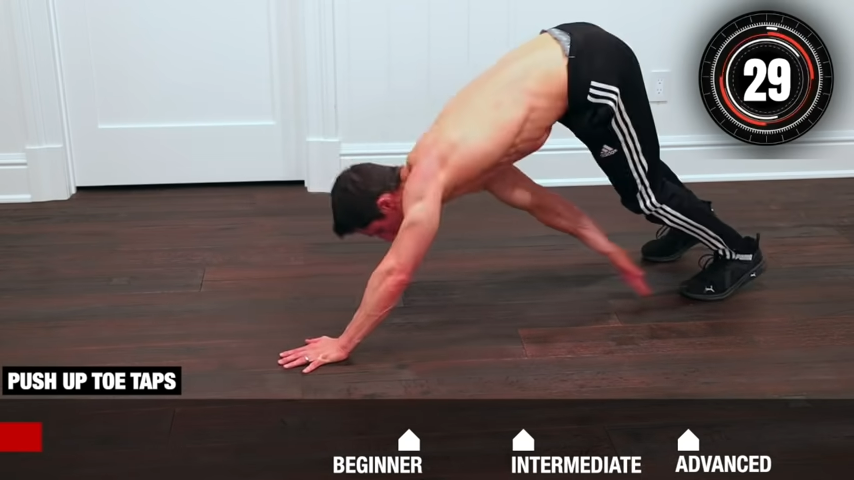
HOW TO DO PUSH-UP TOE TAPS:
- Start in a push-up position.
- Perform a strict regular push-up, but when you reach the top, lift your hips and touch your toe to the opposite hand.
WHAT MAKES IT EFFECTIVE: Another one of my favorite full upper body workout exercises, the Push-up Toe Taps work your upper chest, shoulders, triceps, and core.
SQUAT BURPEES

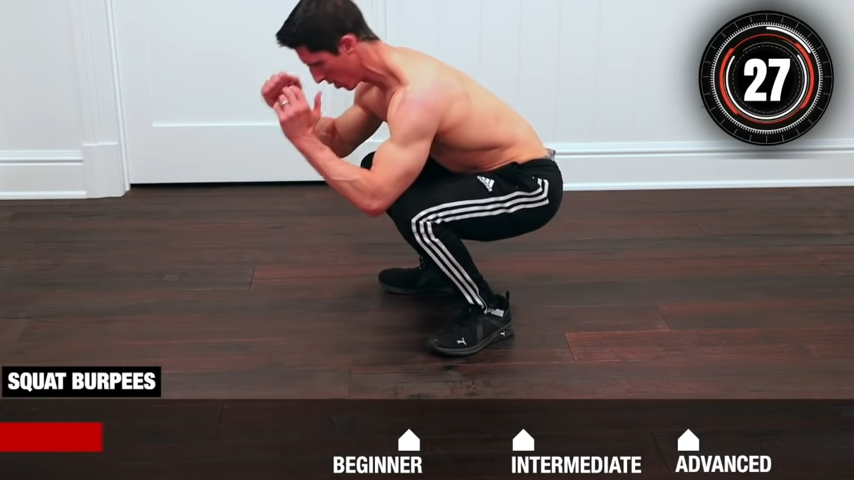
HOW TO DO SQUAT BURPEES:
- To complete this exercise, remain in a push-up position while keeping your body steady. Move your feet so they are spaced hip-width apart or slightly wider.
- Move up with your chest and arms, swing your legs up underneath yourself into a squat position, and land with feet flat on the floor.
- Squat down and hold tightly for a second, then squeeze your glutes before dropping back into the push-up position.
- Repeat this movement until you have completed your set.
- As you start to feel tired, make sure to keep your back straight and legs in a pike position. Don’t let your lower body sag as you jump into the squatting position – focus on keeping those glutes engaged.
WHAT MAKES IT EFFECTIVE: This movement is a variation of the standard floor burpee, but without the jump. This adds it to the list of compound exercises that target your legs, chest, triceps, and core.
STANDING AB TWISTS

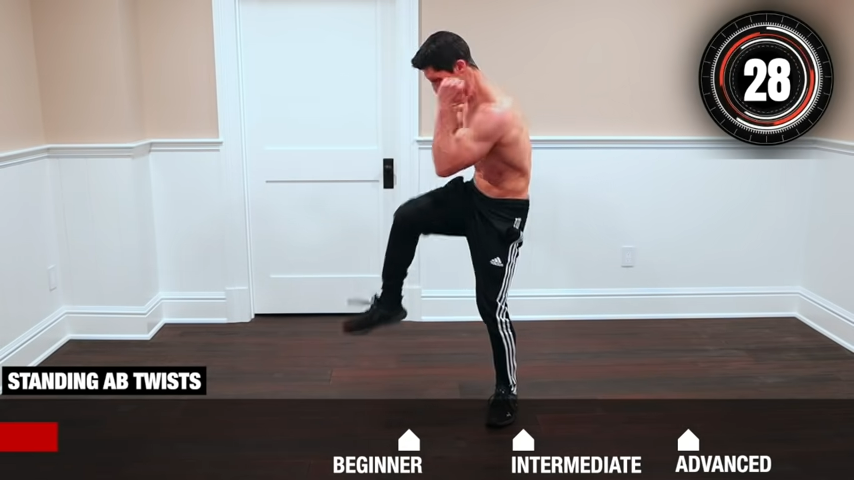
HOW TO DO STANDING AB TWISTS:
- Stand with your feet shoulder-width apart, arms raised like you’re getting ready to punch a bag. Tuck your stomach in by drawing your belly button towards your spine.
- Raise your left knee toward midline while bringing the right elbow down to meet it.
- Then, raise the right knee and left elbow—alternating elbows and knees.
- Lastly, twist in the middle to complete this movement.
- For each rep, push hard to touch your knee to elbow, moving through a complete range of motion and keeping your core engaged the entire time.
WHAT MAKES IT EFFECTIVE: This is a really effective exercise to strengthen your core while improving rotational functional movement patterns.
6) WHAT IS THE BEST FULL BODY WORKOUT FOR BEGINNERS?
I’ve reviewed plenty of options for a full body workout gym and home-based, but what if you are brand new to fitness?
Where should you start to ensure you’re safely learning the fundamentals of full body workouts?
I’ve got you covered. Here’s a beginner full body workout that you can start following today!
PUSH-UP

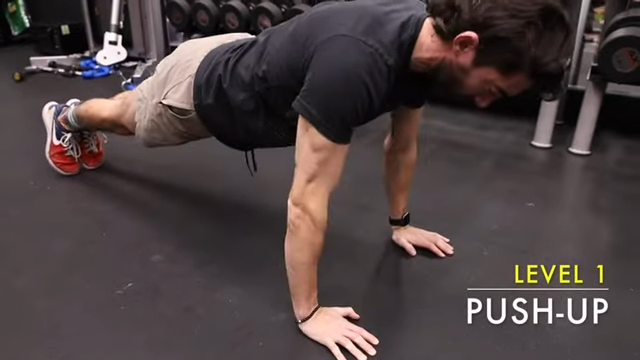
HOW TO DO THE PUSH-UP:
- Place your palms on the ground, shoulder-width apart in a plank position. Your feet should be hip width apart.
- You can do as a Standard or Kneeling Pushup – straight legs or bent knees – depending on your level of fitness. The latter is better for those who cannot yet do a perfect form Pushup.
- Lower your chest to the ground by bending your elbows, then press back up to the starting position. Remember to keep your core engaged throughout the entire exercise!
WHAT MAKES IT EFFECTIVE: This is a horizontal push movement pattern, and it effectively targets the shoulders, chest, and triceps, helping beginners build the mind-to-muscle connections that are needed when just starting out. Personally, the Standard Push-up is one of my favorite exercises because it requires you to maintain control of your shoulders as you place your palms on the ground. I’d recommend it for any full body workout plan for beginners.
ONE-ARM DUMBBELL PRESS

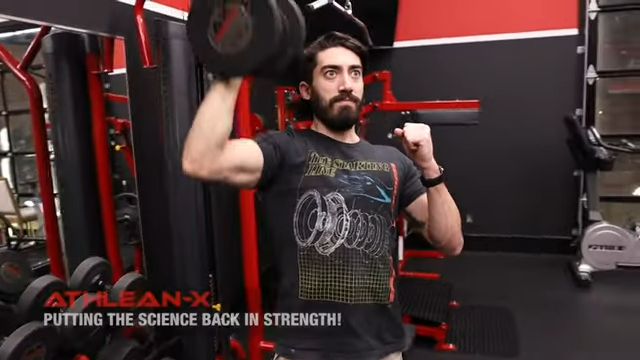
HOW TO DO THE ONE-ARM DUMBBELL PRESS:
- With one hand holding a dumbbell, place your other hand on either your hip or at shoulder level.
- Gently bring the weight up to shoulder height before pressing it straight upward while leaning ever-so-slightly forward. To ensure you are performing the move correctly, place your shoulder so it is moving forward rather than backward.
- Hold the dumbbell overhead with a straight arm.
- After you finish your repetitions, slowly lower the dumbbell back to the starting position. Then, switch sides and repeat the process.
WHAT MAKES IT EFFECTIVE: This next movement pattern is called Vertical Push. This focuses on using the shoulders and triceps to push something overhead in a vertical direction. Moving one arm at a time not only strengthens the imbalances between your right and left side, but also allows you to control your core more easily.
CHEST SUPPORTED ROW


HOW TO DO THE CHEST SUPPORTED ROW:
- Place a pair of dumbbells on the floor in front of an incline bench, so that you can comfortably pick them up.
- As you pull the dumbbells upwards, focus on contracting your back muscles.
- Once your upper arms are level with the floor, pause and then return to the starting position slowly.
WHAT MAKES IT EFFECTIVE: The next movement pattern is Horizontal Pull. The muscles targeted in this pattern are the biceps and back. Being in this position strengthens our lower back muscles without putting any strain on them.
LAT PULLDOWN

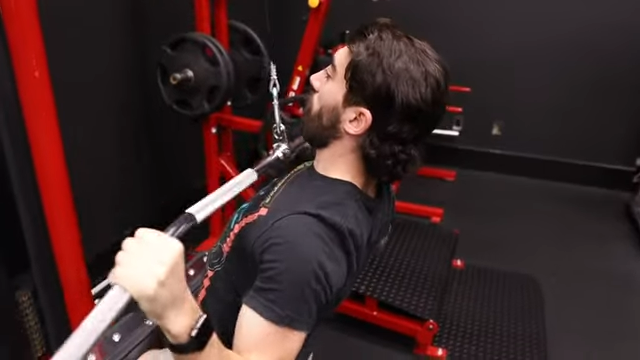
HOW TO DO THE LAT PULLDOWN:
- After you have set the machine to your desired weight, sit on the bench with both feet firmly planted on the ground and knees bent.
- Utilize an overhand grip that is shoulder-width apart when you reach for the bar.
- To work your latissimus dorsi (or lats), which are the muscles on the sides of your back, start by leaning back slightly.
- Then, bring the bar down to your chest while leading with your elbow. Remember to focus that contraction on your lats.
WHAT MAKES IT EFFECTIVE: The next movement pattern is the Vertical Pull. If you’re new to weightlifting, then the Lat Pulldown is an excellent exercise for you to try as it is a perfect way to target the largest muscles in your back.
BANDED PULLDOWN

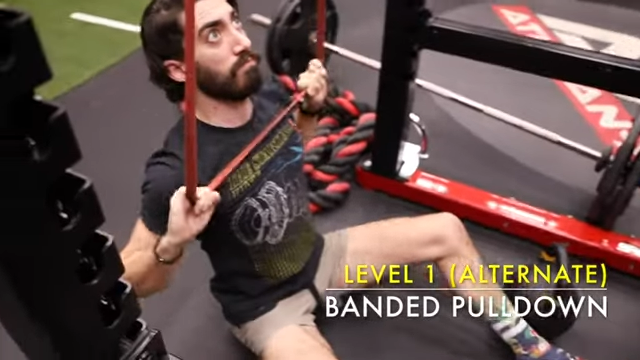
HOW TO DO THE BANDED PULLDOWN:
- Start with a resistance band placed over a Pull-Up bar or similar object. Sit on a bench with both feet firmly planted on the floor.
- Utilize an overhand grip that is shoulder-width apart when you reach for the resistance band.
- To work your latissimus dorsi (or lats), which are the muscles on the sides of your back, start by leaning back slightly.
- Then, bring the resistance band down to your chest while leading with your elbow. Remember to focus that contraction on your lats.
WHAT MAKES IT EFFECTIVE: The one advantage to using bands is that you’ll be using variable resistance, which means consistent tension throughout the entire movement.
CABLE PULL THROUGH

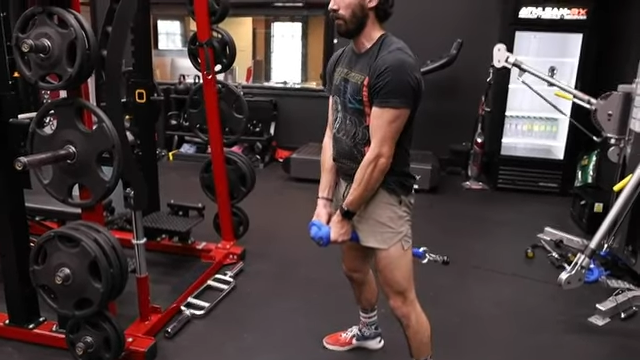
HOW TO DO THE CABLE PULL THROUGH:
- Step back until the ropes are taut and the weight is lifted from the stack, holding both ends of the rope with each hand attached to a cable machine.
- The next step is to focus on hinging back at the hips and then extend powerfully with your hip muscles to drive yourself back up into a vertical position.
WHAT MAKES IT EFFECTIVE: The Cable Pull Through is great for beginners who need to learn to the hinge movement pattern. The hip hinge movement pattern is extremely important for optimal muscular development, which is why this exercise deserves a place in any full body workout for beginners.
DUMBBELL DROP SQUAT


HOW TO DO THE DUMBBELL DROP SQUAT:
- Grasp the top of a dumbbell with both hands, feet shoulder-width apart.
- Ensure your feet are turned out, then kick your hips back as you lower yourself.
- Pause at the bottom before focusing on standing up and contracting your quads.
WHAT MAKES IT EFFECTIVE: Learning the squat movement pattern emphasizes your ability to move your body up and down in a set space. Naturally, the end goal is for you to learn and master the Barbell Squat, but it’s important to start with an easier variation such as the Dumbbell Drop Squat. I really like this exercise because it establishes proper squat form for beginners by ;needing to keep the dumbbell settled in the center of gravity. As a result, your body will align correctly into the squat position.
BODYWEIGHT SPLIT SQUAT


HOW TO DO THE BODYWEIGHT SPLIT SQUAT:
- There’s no need to worry about using a heavy weight or light weight here.
- You won’t be using any weight at all! Place your feet shoulder width apart and squat up and down, similar to a lunge but with one leg out in front of the other.
- Start with the left knee out in front then switch sides after you’ve completed your reps.
WHAT MAKES IT EFFECTIVE: The lunge pattern is an exceptional movement pattern that often gets replaced by other exercises like the Barbell Squat but given its benefits for muscular and movement pattern development, it is critical to master.
BODYWEIGHT REVERSE LUNGE

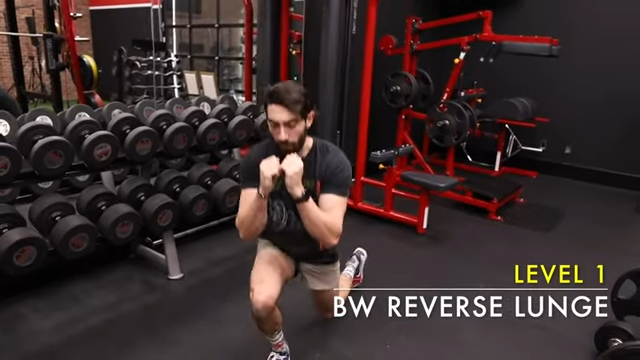
HOW TO DO THE BODYWEIGHT REVERSE LUNGE:
- Start standing with feet together, hands held up in front of you out of the way.
- Then, step backward with your right leg while keeping your left leg in place. Your legs should now be hip width apart (or slightly further depending on your size and build). Step backward and lower your hips until your legs are bent at a 90-degree angle, keeping your front knee directly over ankle and back knee close to the ground.
- Keeping your torso upright, press through your front heel to straighten your left leg and bring your right leg forward so that it meets the left. Return to the starting position and repeat on the other side.
WHAT MAKES IT EFFECTIVE: The Reverse Lunge is my go-to movement pattern to master the dynamic lunge because it’s more forgiving, especially if you have current knee issues. Walking Lunges are great too but only if your knees can handle the strain and you aren’t using heavier weights than you can handle.
ROLLUP


HOW TO DO THE ROLLUP:
- Lie on your back with your arms extended overhead and your legs straight.
- Engage your core muscles and lift your arms up towards the ceiling as you roll forward, bringing yourself into a sitting position.
- Reverse the movement by rolling backwards while maintaining control of your body throughout the exercise.
WHAT MAKES IT EFFECTIVE: The following Pilates movement not only allows you to stand back up from the ground, but also teaches you how to use your core muscles correctly as you make your way back down.
SUITCASE CARRY


HOW TO DO THE SUITCASE CARRY:
- Walk a set distance while holding a dumbbell at one side of your body, then progress to holding the dumbbell on the other side.
- Use light dumbbells to start and gradually increase weight as you get stronger.
- Remember to maintain good posture at all times. This means no slouching! Stand up straight and walk around regularly. If you notice your posture getting worse or if your grip starts to fail, the set is over.
WHAT MAKES IT EFFECTIVE: The last movement pattern is the carry. I believe that this is one of those very important but frequently neglected movement patterns. The Suitcase Carry will aid you in learning how to construct your grip and hand strength, as well as being able to move it dynamically in space.
If you’re looking for a complete beginner full body workout, you can check out my article Best Beginner Full Body Workout.
A full body workout is a great way to target all major muscle groups and improve overall fitness no matter your fitness goal.
The full body program above can be completed at least three times per week and should focus on strict form with an appropriate weight and intensity. You can also do fewer sets to turn this into a 20 to 30 minute full body workout with weights.
Are you looking for a completely done-for-you full body workout? Check out our ATHLEAN-X programs to see which one best fitness your goals and fitness level!
FULL BODY WORKOUT FAQS
The best full body strength training workout should include a combination of exercises that target the major muscle groups, along with exercises that incorporate all seven movement patterns. This type of routine should be completed at least three times per week and should focus on compound movements. You should also take into account when you’ll schedule cardio and a rest day, which typically happens in between workouts.
No, it is not recommended to do a full body training plans every day. The best frequency for full body workouts is three days per week, or every other day. Doing this type of routine too often can lead to overtraining and injury.
Yes, a full body workout can be done three days per week. This is the most common and recommended training frequency for this type of routine as three days per week allows your muscles to have a rest day and recover in between sessions. Don’t forget to make time for cardio in between the 3-day workout split.
Here are five great full body workouts:
An excellent workout for the entire body should include exercises that target the major muscle groups of the body. It should also incorporate all seven movement patterns - squat, push, pull, hinge, lunge, rotate and carry. This type of routine should be completed at least three times per week and should focus on compound movements.
It depends on your goals, but generally a full body training session should include 4-6 exercises. This can be increased or decreased depending on the goals of the individual and their fitness level.
Yes, you can absolutely build muscle with full body workouts. This type of routine allows you to hit all major muscle groups more frequently and stimulate more frequent protein synthesis, which is going to be great for building muscles. This leads to greater gains in strength and lean muscle mass.
Yes, a full body weight training program can get you ripped as long as they are done with proper intensity and frequency. It is important to focus on compound movements and to ensure that each workout provides enough stimulus for muscle growth. With the right program, full body workouts can help you reach your physique goals.
Yes, 20 minute full body workouts can be effective if they are done with the right intensity and frequency. This type of routine is great for those who have limited time but still want to get in a good workout. Just make sure to include exercises that target all major muscle groups and focus on compound movements.
REFERENCES

Jeff Cavaliere M.S.P.T, CSCS
Jeff Cavaliere is a Physical Therapist, Strength Coach and creator of the ATHLEAN-X Training Programs and ATHLEAN-Rx Supplements. He has a Masters in Physical Therapy (MSPT) and has worked as Head Physical Therapist for the New York Mets, as well as training many elite professional athletes in Major League Baseball, NFL, MMA and professional wrestling. His programs produce “next level” achievements in muscle size, strength and performance for professional athletes and anyone looking to build a muscular athletic physique.
















